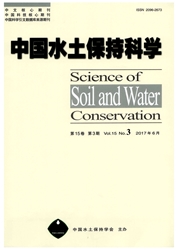

 中文摘要:
中文摘要:
以云雾山不同封育年限草地针茅植物根系和土壤为研究对象,对其根系特征、土壤特性及两者关系进行研究,以探讨分析封育对针茅根系格局的影响。结果表明:(1)针茅植物根系生物量、根长密度、根表面积和根体积在封育初期轻微下降,之后缓慢上升,并在封育30 a草地得到显著增加。(2)随封育年限增加,各根系指标在3种针茅物种间的组成格局具有类似变化规律,具体表现为:长芒草在放牧草地所占比例最高,之后逐渐降低,并在封育30 a草地消失;大针茅所占比例呈先升后降变化规律,并在封育22 a草地达到最大值;甘青针茅仅出现于封育30 a草地,且占据优势地位。(3)大针茅和甘青针茅0-0.6 mm径级根系比例高于大针茅,使其根系直径显著低于大针茅,比根长和比根面积显著高于大针茅;此外,长芒草根组织密度显著高于长芒草和甘青针茅。(4)长期封育在显著提高土壤水分、养分含量和土壤氮磷比的同时显著降低土壤碳氮比,但对微生物生物量碳、氮无明显影响。(5)针茅根系特征与土壤指标的关联性分析显示针茅根系受土壤氮资源的显著影响。
 英文摘要:
英文摘要:
We selected five grassland sites with different grazing exclusion times (0, 5, 9, 22, and 30 years) on Yunwu Mountain as the study sites, where the roots of Stipa plants in the 0-30 cm soil layer and soil of the 0-20 cm soil layer were collected. Roots were washed and identified to the species level based on attached aboveground parts and root color, texture, and branching. Root samples of the same species were scanned using an Epson Scanner to obtain images for analysis of root morphological traits using WinRhizoPro software. Root length, surface area, and volume were analyzed at 0.1 mm intervals in root diameter, the measurements of which could be used for calculations of specific root length (SRL), specific root surface area (SRS), and root tissue density (RTD). Soil samples were analyzed to determine soil moisture, soil bulk density, soil pH, soil organic carbon, total soil nitrogen, total soil phosphorous, available soil nitrogen, available soil phosphorus, microbial biomass carbon, and microbial biomass nitrogen. One-way analysis of variance was conducted to determine the effect of grazing exclusion time on Stipa root traits, and to determine differences in the roots of different Stipa species. Redundancy analysis was conducted to determine soil variables that best explain the variations in Stipa root traits. The main results were as follows. (1) The root biomass, root length density, root surface area, and root volume of Stipa plants showed a slight decrease at the beginning of grazing exclusion, but thereafter gradually increased and showed significant increases in grassland with grazing exclusion for 30 years. (2) All of the root trait indexes showed similar species compositional changes with grazing exclusion time. Specifically, the proportion of Stipa bungeana was the highest in grazed grassland, then gradually declined with grazing exclusion time, and disappeared after 30 years' grazing exclusion; the proportion of Stipa grandis initially increased, peaked in grasslands after
 同期刊论文项目
同期刊论文项目
 同项目期刊论文
同项目期刊论文
 Trend of streamflow, sediment load and their dynamic relation for the catchments in the middle reach
Trend of streamflow, sediment load and their dynamic relation for the catchments in the middle reach Spatiotemporal characteristics of Precipitation and the extreme events in 1957-2009 on the Loess Pla
Spatiotemporal characteristics of Precipitation and the extreme events in 1957-2009 on the Loess Pla Responses of vegetation cover to the Grain for Green Program and their driving forces in the He-Long
Responses of vegetation cover to the Grain for Green Program and their driving forces in the He-Long Long-term streamflow trendsin the middle reaches of the Yellow River Basin: detecting drivers of cha
Long-term streamflow trendsin the middle reaches of the Yellow River Basin: detecting drivers of cha 期刊信息
期刊信息
